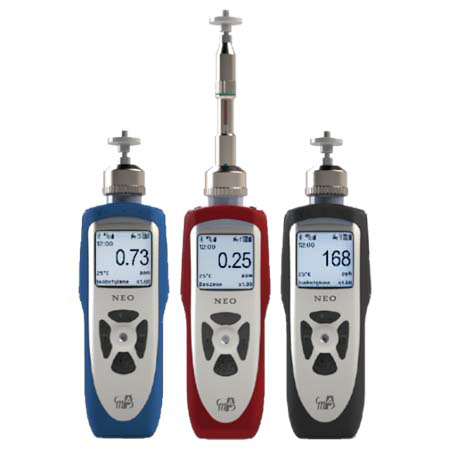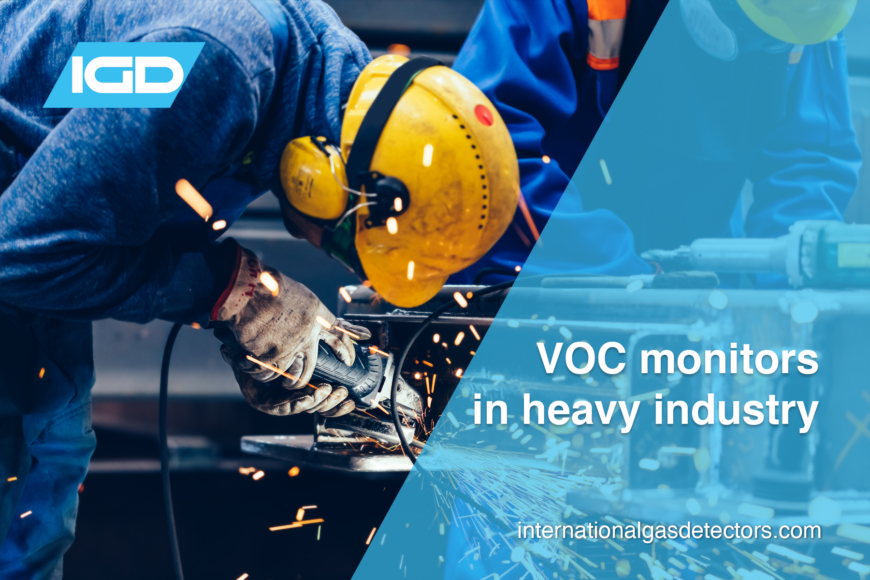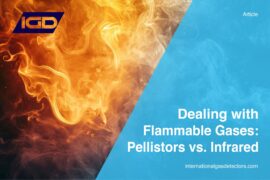Exposure to harmful volatile organic compounds (VOCs) can cause a variety of acute and chronic health problems. Since VOCs are produced in especially high concentrations in heavy industry, it’s essential for the safety and wellbeing of personnel that reliable and accurate VOC monitors are installed in these environments. In this post, we take a look at what VOCs are, the risks they pose in heavy industry, and how VOC monitors can help minimize these risks.
What Are Volatile Organic Compounds?
The term “volatile organic compound” is a fairly broad definition. It encompasses any organic compound (i.e., any molecule containing carbon-hydrogen bonds) which meets a certain minimum level of volatility, that is, a certain propensity to evaporate in air. The European Union’s VOC Solvents Directive defines a VOC as, “any organic compound having at 293.15 K a vapor pressure of 0.01 kPa or more (or having a corresponding volatility under the particular conditions of use).”1
This broad definition means that not all VOCs are necessarily harmful: numerous VOCs play important roles in a number of biochemical processes in healthy plants and animals. However, many of the VOCs produced in heavy industry represent a serious threat to health.
What are the Dangers of VOCs?
Known carcinogenic and toxic VOCs include benzene, toluene, ethyl-benzene, xylenes, styrene and formaldehyde. The most common effects of exposure to harmful VOCs are immediate: these include irritation to the eyes and throat, dizziness, nausea, and in rare cases, unconsciousness or death.
However, the effects of long-term exposure to VOCs are even more troublesome. These include hormonal disruption; damage to the liver, kidneys and central nervous system and even cancer. VOCs are therefore a fundamental parameter in assessing air quality, and VOC monitors play an essential role in ensuring safety.
What are the Major Sources of VOCs?
Major anthropogenic (man-made) sources of harmful VOCs include fossil fuel use and production, solvents used in coatings and paints, and compressed aerosol products. VOCs are of particular concern in heavy industries such as steel foundries and refineries, where particularly harmful VOCs are typically present in high concentrations.

Anthropogenic VOCs are regulated by law, especially indoors where concentrations are typically up to ten times higher.
Mitigating the Risks of VOCs in Heavy Industry
In industrial environments, it is crucial that VOC monitors are deployed to measure atmospheric VOC levels and ensure personnel safety.
A number of different types of VOC monitors exist, and installations are typically application-specific. Fixed VOC monitors can be used to keep specific hazards in check – these are commonly deployed where emissions or leaks are particularly likely and/or particularly dangerous. Fixed devices range from site-wide area addressable detectors to standalone VOC monitors for small areas. It is worth to note that some VOC gases such as ammonia, carbon monoxide and formaldehyde do have specific sensors available. Therefore where there is a specific sensor for your target gas always install these. As VOC detection and gas detection in general is a very specialised industry, then you may need support from industry experts, which are team are on hand to assist.
Individual members of personnel can also carry portable VOC monitors to monitor their immediate surroundings. These use highly sensitive detectors to provide real-time feedback on VOC levels to members of staff who are moving from place to place and may be subject to unexpected VOC hazards. For example, the PID NEO is the perfect solution from IGD and uses world-leading PID detector technology to provide detection of over 700 VOCs.
VOC Monitors from International Gas Detectors
IGD is experienced in the design and specification of effective VOC monitors and detection systems for all applications. We have over two decades of VOC detection experience and over a century of gas detection manufacturing experience.

This allows us to provide clients with the best-in-class VOC monitors. Our range includes ATEX/IECEx detectors designed for use in potentially explosive atmospheres or areas that are exposed to outside elements. These applications can include process monitoring, petrochemical, waste water and hazardous chemical storage. The TOC-750X is world leading ATEX VOC monitor for ATEX zoned applications, with a range of accessories to suit your application.

The TOC-750 safe area and TOC-750S aspirated detectors are designed for less harsh and commercial/research applications. These safe area detectors use the same sensors, electronics and software as the ATEX units. Safe area detectors go through the same quality system and test procedures. The only difference is the housing, if ATEX is not required then you do not need to pay for it! Some common applications for the TOC-750 safe area addressable and TOC-750S aspirated VOC monitor include:
- University
- Research
- Medical
- Semiconductor manufacturing
- Cleanrooms
- IVF treatment and Virology labs
- Air quality and environmental checking
- Light industrial
Our TOC-750 series gas detectors all utilise our leading addressable technology. This provides clients with a 10 year warranty on electronics and 80% more capability per detector. In addition they are all fitted with our industry unique and leading PID sensor technology. Our new design features a 50% longer lamp life than current alternatives. In addition our new design ensures the common issues of humidity and the effects of sputtering are negated. This ensures when you receive a VOC monitor from IGD you are backed by 100+ years of experience and a reliable, accurate VOC monitor.

In addition to fixed monitors we provide a range of portable devices. The PID NEO is designed for accurate portable VOC detection. From 1ppb up to 15,000ppm. It also has a built in table of 700 VOC gases, data recording and benzene specific options. It truly is a detectably better portable VOC monitor. Where there is more than just VOC gas hazards then the POLI is the perfect solution. Designs to monitor 4-5 gases including VOC in a compact easy to use platform. The POLI also features a built in cross factor list for VOC gases and boasts one of the largest sensor options available in a portable offering.

Contact the Experts in VOC Detection
Whether you require a site survey, fixed or portable detection or need full project support, then speak to the team at IGD. With over 100 years of experience in gas detection, you are receiving help and guidance from world leading gas detection experts.




